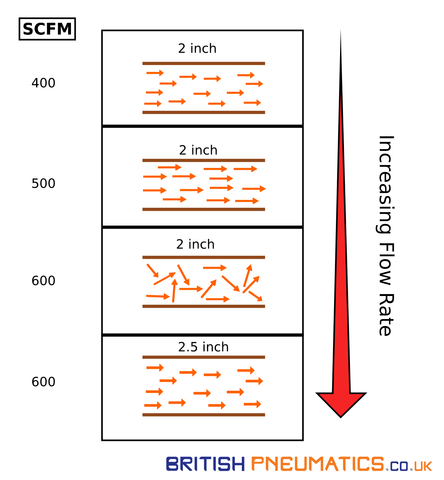How Does Pneumatic Tubing Size Affect Flow Rate
Pneumatic tubing is a crucial component of a pneumatic system as it carries the pressurized air between the actuators, valves, and other pneumatic components. Importantly, it is the ize of the pneumatic tubing that dictates the flow rate of air through the system and, consequently, also the air volume that the actuator is getting in each cycle.
To understand how pneumatic tubing affects the flow rate, let us address the basics of airflow in a pneumatic system.
Generation of Flow
In a pneumatic system, the air compressor is the component that acts as the main driver for airflow. It compresses the air and increases its pressure. Due to this high pressure on one end, a pressure difference is created in the circuit, which directs air toward the low-pressure end. The resulting velocity of the air can be calculated using the equation below:

|
Here, v = Velocity of air ΔP = Change in pressure ρ = Density of air |
Flow Rate Through the Pipe
From the above equation, it can be seen that the velocity of air is dependent only on the pressure difference and density. In other words, the pipe geometry does not affect the velocity of the air.
On the contrary, it is the term of cross-sectional area in the equation of flowrate, as shown below, which is increasing the flow rate as the pipe’s diameter increases.

|
Here, v = Velocity of air A = Cross-sectional area of the pipe Q = Volumetric flow rate |
Where does this come into play?
While it is essential to understand this concept for general understanding, it is also crucial in designing pneumatic systems. From the above explanation, it is clear that the flow rate can be increased by increasing either the pipe cross-sectional area or velocity of the air. Nonetheless, both have their cons. Larger pipes increase costs as the material costs increase. In contrast, higher velocities cause the flow to enter the turbulent region as shown in the figure below and increase the friction losses. Therefore, the usual recommendation is to opt for a bigger pipe if the flow is turbulent.

Choosing the Right Diameter
While the required diameter of the pneumatic tubing depends on the operating conditions, the overall cycle time has a major say in it. Cycle time is dependent upon the amount of air entering the actuator in a given time. By increasing the tubing size, we increase the flow rate of air and reduce the cycle time.
For example, pneumatic brakes used in amusement rides apply a set amount of force in a pre-defined time to stop the ride motion. By varying the flow rate, sudden jolts and slow-motion intervals can be produced in the ride. Similarly, blow moulding in the food packaging industry also employs compressed air. By increasing the flow rate of air, the time for blow moulding a part can be reduced and production capacity can be increased.
